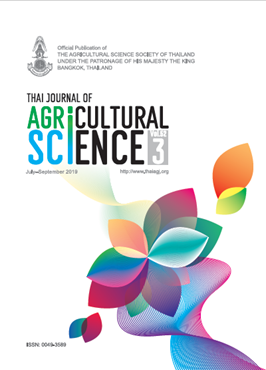Light Quality Affects Shoot Multiplication of Vanilla pompana Schiede in Micropropagation
Main Article Content
Abstract
The influence of different light quality in vitro culture of Vanilla pompana Schiede to accelerate shoot induction and shoot multiplication were investigated in this study. Nodal segments of V. pompano with one node (12–15 mm in length) were cultured for 90 days on MS medium supplemented with 30 gL-1 sucrose and 8 mgL-1 BA under 7 treatments of different light qualities, including fluorescent (FF) as the control, White (WW), Red + Blue 1 : 1 (RB), Red + White 1 : 1 (RW), Blue + White 1 : 1 (BW), Blue (BB) and Red (RR) light-emitting diodes (LEDs). The results demonstrated that bud of every nodal segments regenerated shoot and continuously elongated to 0.8–2.0 cm. A combination between blue and red LEDs enhanced vegetative growth of the first regenerated shoot with increased shoot length, node number and leaf number, while monochromatic red lighting suppressed these factors. Furthermore, white LEDs resulted in the highest percentage of callus induction from nodal segment with a rapid increase for first 30 days of the culture period. Multiple shoots generated from both lateral bud of first main shoot and differentiated from callus at 90 days. The monochromatic blue LEDs promoted the greatest callus differentiation with the highest total multiple shoots. The blue (BB) and red (RR) LED light promote the highest number of multiple shoots regeneration as same as fluorescent light. These results are able to contribute to use the blue (BB) and red (RR) LED light substitution of fluorescence light for V. pompano micropropagation and can reduced annual electrical cost.


